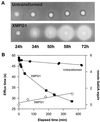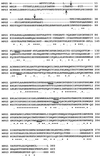Polygalacturonase gene expression in ripe melon fruit supports a role for polygalacturonase in ripening-associated pectin disassembly
- PMID: 9625689
- PMCID: PMC34956
- DOI: 10.1104/pp.117.2.363
Polygalacturonase gene expression in ripe melon fruit supports a role for polygalacturonase in ripening-associated pectin disassembly
Abstract
Ripening-associated pectin disassembly in melon is characterized by a decrease in molecular mass and an increase in the solubilization of polyuronide, modifications that in other fruit have been attributed to the activity of polygalacturonase (PG). Although it has been reported that PG activity is absent during melon fruit ripening, a mechanism for PG-independent pectin disassembly has not been positively identified. Here we provide evidence that pectin disassembly in melon (Cucumis melo) may be PG mediated. Three melon cDNA clones with significant homology to other cloned PGs were isolated from the rapidly ripening cultivar Charentais (C. melo cv Reticulatus F1 Alpha) and were expressed at high levels during fruit ripening. The expression pattern correlated temporally with an increase in pectin-degrading activity and a decrease in the molecular mass of cell wall pectins, suggesting that these genes encode functional PGs. MPG1 and MPG2 were closely related to peach fruit and tomato abscission zone PGs, and MPG3 was closely related to tomato fruit PG. MPG1, the most abundant melon PG mRNA, was expressed in Aspergillus oryzae. The culture filtrate exponentially decreased the viscosity of a pectin solution and catalyzed the linear release of reducing groups, suggesting that MPG1 encodes an endo-PG with the potential to depolymerize melon fruit cell wall pectin. Because MPG1 belongs to a group of PGs divergent from the well-characterized tomato fruit PG, this supports the involvement of a second class of PGs in fruit ripening-associated pectin disassembly.
Figures






Similar articles
-
Temporal sequence of cell wall disassembly in rapidly ripening melon fruit.Plant Physiol. 1998 Jun;117(2):345-61. doi: 10.1104/pp.117.2.345. Plant Physiol. 1998. PMID: 9625688 Free PMC article.
-
Temporal and spatial expression of polygalacturonase gene family members reveals divergent regulation during fleshy fruit ripening and abscission in the monocot species oil palm.BMC Plant Biol. 2012 Aug 25;12:150. doi: 10.1186/1471-2229-12-150. BMC Plant Biol. 2012. PMID: 22920238 Free PMC article.
-
Insights into the effects of polygalacturonase FaPG1 gene silencing on pectin matrix disassembly, enhanced tissue integrity, and firmness in ripe strawberry fruits.J Exp Bot. 2013 Sep;64(12):3803-15. doi: 10.1093/jxb/ert210. Epub 2013 Jul 19. J Exp Bot. 2013. PMID: 23873994 Free PMC article.
-
Fruit softening and pectin disassembly: an overview of nanostructural pectin modifications assessed by atomic force microscopy.Ann Bot. 2014 Oct;114(6):1375-83. doi: 10.1093/aob/mcu149. Epub 2014 Jul 25. Ann Bot. 2014. PMID: 25063934 Free PMC article. Review.
-
Cell wall metabolism in fruit softening and quality and its manipulation in transgenic plants.Plant Mol Biol. 2001 Sep;47(1-2):311-40. Plant Mol Biol. 2001. PMID: 11554479 Review.
Cited by
-
Cellular and Pectin Dynamics during Abscission Zone Development and Ripe Fruit Abscission of the Monocot Oil Palm.Front Plant Sci. 2016 Apr 26;7:540. doi: 10.3389/fpls.2016.00540. eCollection 2016. Front Plant Sci. 2016. PMID: 27200017 Free PMC article.
-
Knock-Out of CmNAC-NOR Affects Melon Climacteric Fruit Ripening.Front Plant Sci. 2022 Jun 10;13:878037. doi: 10.3389/fpls.2022.878037. eCollection 2022. Front Plant Sci. 2022. PMID: 35755703 Free PMC article.
-
Expression of a polygalacturonase associated with tomato seed germination.Plant Physiol. 1999 Oct;121(2):419-28. doi: 10.1104/pp.121.2.419. Plant Physiol. 1999. PMID: 10517833 Free PMC article.
-
Candidate genes and QTLs for fruit ripening and softening in melon.Theor Appl Genet. 2008 Feb;116(4):589-602. doi: 10.1007/s00122-007-0694-y. Epub 2007 Dec 20. Theor Appl Genet. 2008. PMID: 18094954
-
BcMF9, a novel polygalacturonase gene, is required for both Brassica campestris intine and exine formation.Ann Bot. 2009 Dec;104(7):1339-51. doi: 10.1093/aob/mcp244. Epub 2009 Oct 8. Ann Bot. 2009. PMID: 19815569 Free PMC article.
References
-
- Allen RL, Lonsdale DM. Molecular characterization of one of the maize polygalacturonase gene family members which are expressed during late pollen development. Plant J. 1993;3:261–271. - PubMed
-
- Bernatzky R, Tanksley SD. Genetics of actin-related sequences in tomato. Theor Appl Genet. 1986;72:314–321. - PubMed
-
- Bonghi C, Rascio N, Ramina A, Casadoro G. Cellulase and polygalacturonase involvement in the abscission of leaf and fruit explants of peach. Plant Mol Biol. 1992;20:839–848. - PubMed
Publication types
MeSH terms
Substances
LinkOut - more resources
Full Text Sources

